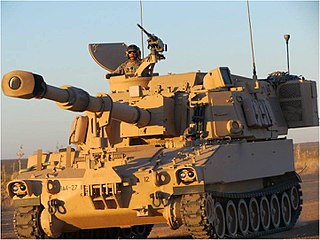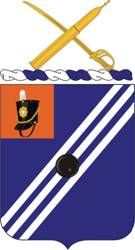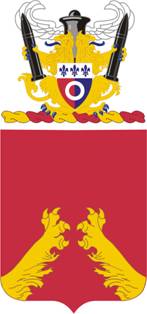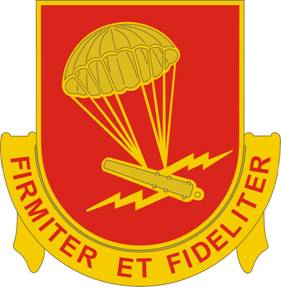 W
WThe 168th Field Artillery Regiment was a Field Artillery Branch regiment of the Army National Guard.
 W
WThe 1st Battalion, 194th Field Artillery Regiment is a field artillery battalion of the United States Army National Guard. It is assigned to the 2nd Infantry Brigade Combat Team, 34th Infantry Division in the Iowa Army National Guard as its direct support battalion.
 W
WThe 2nd Battalion, 3rd Field Artillery Regiment is an artillery unit of the United States Army. The battalion traces its lineage to 1812, and it is currently assigned to the 1st Brigade Combat Team, 1st Armored Division. The battalion has served in the Seminole Wars, the Civil War, the Spanish–American War, World War I, World War II, Operations Desert Shield and Desert Storm, Operation Iraqi Freedom, and Operation Enduring Freedom.
 W
WThe 6th Field Artillery Regiment is a Field Artillery Branch regiment of the United States Army first activated in 1907 from numbered companies of artillery. It was first organized with two battalions.
 W
WThe 14th Field Artillery Regiment is a parent field artillery regiment of the United States Army, currently represented in the Regular Army by its 1st Battalion, a HIMARS unit with the 75th Field Artillery Brigade at Fort Sill, Oklahoma.
 W
WThe 3rd Battalion, 16th Field Artillery Regiment is a field artillery battalion assigned to the 2nd Brigade Combat Team, 1st Cavalry Division. Carrying the lineage of Battery C, 16th Field Artillery Regiment, the battalion carries campaign streamers from World War I, World War II, and Vietnam, and has served with the 4th Infantry Division and 8th Infantry Division. The unit's nickname is "Rolling Thunder" and their motto is "Macte Nova Virtute". The battalion is composed of a headquarters and headquarters battery (HHB), three cannon batteries, and has an attached Forward Support Company, Company F, 15th Brigade Support Battalion.
 W
WThe 1st Battalion, 21st Field Artillery was a field artillery battalion of the United States Army based in Fort Hood, Texas. It was a subordinate unit of the 41st Fires Brigade.
 W
WThe 2nd Battalion, 27th Field Artillery Regiment is an inactive field artillery battalion of the United States Army, last assigned to the 3rd Armored Division Artillery before its inactivation in 1988. Its parent regiment is the 27th Field Artillery Regiment.
 W
WThe 4th Battalion of the 27th Field Artillery Regiment is a mechanized artillery battalion stationed at Fort Bliss, Texas. One of five combat battalions assigned to the 2nd Brigade Combat Team (1AD), 4-27 FA currently fields approximately 600 artillery and support personnel, operating self-propelled M109A6 howitzers, and providing direct fire support to the brigade.
 W
WThe 1st Battalion, 30th Field Artillery Regiment is a field artillery training battalion assigned to the 428th Field Artillery Brigade of the United States Army Field Artillery School at Fort Sill, OK. The battalion teaches Field Artillery Basic Officer Leaders Course, Phase 2(BOLC-B); Warrant Officer Basic Course (WOBC); Warrant Officers' Advanced Course (WOAC), CCC and functional courses.
 W
WThe 4th Battalion, 42nd Field Artillery Regiment nicknamed the Straight Arrows—was a field artillery battalion in the United States Army. The Regimental motto is Festina Lente.
 W
WThe 1st Battalion, 76th Field Artillery Regiment is an inactive field artillery battalion of the United States Army. The battalion has been assigned to the 3rd Infantry Division, 7th Infantry Division, 2nd Infantry Brigade, and as a separate field artillery battalion. The battalion has participated in World War I, World War II, Operation Iraqi Freedom, and Operation Enduring Freedom. The battalion inactivated in 2015 as part of Army force reductions.
 W
WThe 101st Field Artillery regiment is the oldest field artillery regiment in the United States Army with a lineage dating to 13 December 1636 when it was organized as the South Regiment. It is one of several National Guard units with colonial roots and campaign credit for the War of 1812. For the first 250 years of the unit's existence it served in infantry formations.
 W
WThe 1st Battalion, 120th Field Artillery Regiment, also known as the "Red Fox" Battalion came into being on 22 September 1917 at Camp MacArthur, Waco, Texas, as part of the 57th Field Artillery Brigade, better known as the Iron Brigade. The 120th Field Artillery Regiment previously had been the 1st Wisconsin Cavalry. The history of the 1st Wisconsin Volunteer Cavalry Regiment goes back the American Civil War days.
 W
WThe 157th Field Artillery Regiment is a United States Army Regimental System field artillery parent regiment of the United States Army National Guard, represented in the Colorado Army National Guard by the 3rd Battalion, 157th Field Artillery Regiment, part of the 169th Field Artillery Brigade at Colorado Springs.
 W
WThe 1st Battalion, 161st Field Artillery Regiment is a Field Artillery battalion of the Kansas Army National Guard in Kansas. Like many National Guard field artillery battalions, it is the sole battalion in the regiment. The battalion is currently headquartered in Hutchinson, and consists of three firing batteries: Alpha, Bravo (Abilene), Charlie (Newton), and a Headquarters Battery (Hutchinson). The battalion has a direct support relationship with the 1161st Forward Support Company. The battalion's higher headquarters is the 130th Field Artillery Brigade (Manhattan).
 W
WThe 86th Field Artillery Regiment is a inactive parent field artillery regiment of the United States Army, last represented in the Vermont Army National Guard by the 1st Battalion, 86th Field Artillery Regiment. Perpetuating the Vermont Light Artillery Batteries of the American Civil War and subsequent Vermont artillery units, the regiment was organized following World War II as the 206th Field Artillery Battalion in the Vermont National Guard. The 206th saw active service in Germany with the 43rd Infantry Division during the Korean War, and became the 124th Artillery, a Combat Arms Regimental System parent regiment, in 1959. Represented by the 1st Howitzer Battalion, 124th Artillery, the regiment was renumbered as the 86th Artillery in 1964 when the 1st Battalion became the brigade artillery battalion of the 86th Armored Brigade. The 1st Battalion served in that role with the brigade for much of the rest of its existence.
 W
WThe 3rd Battalion, 319th Field Artillery Regiment is the field artillery battalion that directly supports the 1st Brigade Combat Team, 82nd Airborne Division. Known as the "Gun Devils", 3–319th AFAR has participated in battles from World War I to the current day, and is one of the most highly decorated field artillery units in the United States Army. The battalion's mission is "3-319th AFAR stands ready to deploy worldwide within 18 hours of notification, execute a parachute assault and conduct full-spectrum operations. Specifically, the battalion will provide responsive lethal and nonlethal fires in support of forcible entry and airfield seizure, and integrate and synchronize the effects of fires to achieve the 1BCT commander's intent."
 W
WThe 4th Battalion, 319th Field Artillery Regiment is the field artillery battalion assigned to the 173rd Airborne Brigade Combat Team. Nicknamed "The King of the Herd", 4–319th AFAR has participated in battles from World War I to current operations around the globe. The battalion's mission is to provide direct supporting fires to the brigade. The unit is skilled in both the art of integrating and synchronizing all available fire support assets and in the science of delivering accurate and timely lethal and non-lethal fires. "King of the Herd" Paratroopers in the 173rd Infantry Brigade Combat Team (Airborne) are able to accomplish both of these tasks and other assigned missions after rapidly deploying via parachute assault.
 W
WThe 1st Battalion, 320th Field Artillery Regiment is the field artillery battalion assigned to the 2nd Brigade Combat Team, 101st Airborne Division. The battalion has been assigned to the 82nd Airborne Division, 11th Airborne Division and 101st Airborne Division. The battalion has participated in World War I, World War II, Operation Power Pack, Operation Urgent Fury, Operation Desert Storm, Operation Iraqi Freedom, Operation Enduring Freedom, and Operation Inherent Resolve.
 W
WThe 2nd Battalion, 320th Field Artillery Regiment is an inactive field artillery battalion of the United States Army. The battalion has been assigned to the 82nd Airborne Division, 11th Airborne Division and 101st Airborne Division. The battalion has participated in World War I, World War II, Vietnam, Operation Desert Storm, Operation Iraqi Freedom, and Operation Enduring Freedom. The battalion deactivated in July 2015 as part of ongoing force reductions, and its personnel and equipment were reflagged as the 2nd Battalion, 32nd Field Artillery Regiment.
 W
WThe 3rd Battalion, 320th Field Artillery Regiment is a Field Artillery Branch battalion assigned to the 3rd Brigade Combat Team, 101st Airborne Division. The battalion has been assigned to the 82nd Airborne Division, 11th Airborne Division and 101st Airborne Division. The battalion has participated in World War I, World War II, Operation Desert Storm, Operation Enduring Freedom, and Operation Iraqi Freedom.
 W
WThe 4th Battalion, 320th Field Artillery Regiment is an inactive field artillery battalion of the United States Army. The battalion has been assigned to the 82nd Airborne Division, 11th Airborne Division and 101st Airborne Division. The battalion has participated in World War I, World War II, Operation Just Cause, Operation Iraqi Freedom, and Operation Enduring Freedom. The battalion inactivated in 2014 as part of ongoing force reductions
 W
WThe 1st Battalion, 321st Field Artillery Regiment is an inactive field artillery battalion of the United States Army. The battalion served in World War I, World War II, Vietnam and the Global War on Terror with the 82nd Airborne and 101st Airborne Divisions, and with the 18th Field Artillery Brigade. The battalion was officially inactivated in March 2014, and its firing batteries were distributed throughout the 82nd Airborne Division.
 W
WThe 2nd Battalion, 321st Field Artillery Regiment is an inactive field artillery battalion of the United States Army. The battalion served in World War I, World War II, Vietnam and the Global War on Terrorism with the 82nd Airborne and 101st Airborne Divisions. The battalion was inactivated in 2014 as part of force reductions.
 W
WThe 3rd Battalion, 321st Field Artillery Regiment is an artillery battalion, assigned to the 18th Field Artillery Brigade, part of the US Army XVIII Airborne Corps at Fort Bragg, NC. The battalion has served in World War I, World War II, and the Global War on Terror. The battalion is equipped with M142 HIMARS rocket launchers.
 W
WThe 333rd Field Artillery Battalion was a racially segregated United States Army unit of African-American troops during World War II.
 W
WThe 1st Battalion, 377th Field Artillery Regiment, is an inactive M198 howitzer 155mm field artillery battalion of the United States Army. The battalion has seen service with the 101st Airborne Division during World War II and Vietnam, and deployed to Iraq and Afghanistan during the Global War on Terror. The battalion has been stationed with the 101st Airborne Division at Fort Campbell; with the 18th Field Artillery Brigade and the 82nd Airborne Division at Fort Bragg, North Carolina; and with the 17th Field Artillery Brigade at Fort Lewis, Washington.
 W
WThe 2nd Battalion, 377th Field Artillery Regiment, is the field artillery battalion assigned to the 4th Brigade Combat Team (Airborne), 25th Infantry Division of the United States Army. This battalion is also known as the 2nd Airborne Battalion, 377th Field Artillery Regiment, or the 2nd Battalion, 377th Parachute Field Artillery Regiment.
 W
WThe 460th Parachute Field Artillery Battalion was an airborne field artillery battalion of the United States Army that saw active service during World War II. Active from 1943–1946, the battalion trained with the 17th Airborne Division; served with the 517th Parachute Regimental Combat Team in the Italian Campaign, Operation Dragoon, and the Battle of the Bulge; and ended the war assigned to the 13th Airborne Division before inactivation.
 W
WThe Lost Battalion was the 2nd Battalion, 131st Field Artillery, 36th Infantry Division of the U.S. Army. The men of the battalion, plus the survivors of the sunken cruiser USS Houston, were captured by the Japanese on the island of Java in the Dutch East Indies in March 1942. It is called the lost battalion because the fate of the men was unknown to the United States until September 1944. They were prisoners of war for 42 months until the end of World War II. 534 soldiers from the battalion and 368 survivors of the Houston were taken prisoner. Most of the men were sent to Thailand to work on the Burma Railway, the building of which is portrayed in the film The Bridge on the River Kwai. Of the 902 soldiers and sailors taken captive, 163 died in captivity. Most of the prisoners of war were from western Texas.